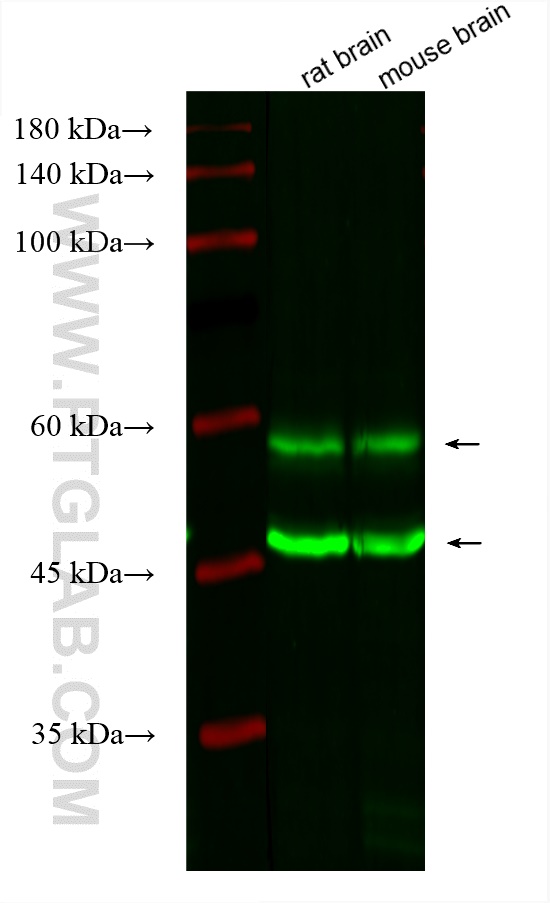验证数据展示
经过测试的应用
| Positive WB detected in | rat brain tissue, mouse brain tissue |
For other applications, we recommend the unconjugated version of this antibody, 66843-1-Ig
推荐稀释比
| 应用 | 推荐稀释比 |
|---|---|
| Western Blot (WB) | WB : 1:1000-1:8000 |
| It is recommended that this reagent should be titrated in each testing system to obtain optimal results. | |
| Sample-dependent, Check data in validation data gallery. | |
产品信息
CL488-66843 targets CAMK2 in WB applications and shows reactivity with Human, Mouse, Rat, Pig samples.
| 经测试应用 | WB Application Description |
| 经测试反应性 | Human, Mouse, Rat, Pig |
| 免疫原 | CAMK2 fusion protein Ag4736 种属同源性预测 |
| 宿主/亚型 | Mouse / IgG1 |
| 抗体类别 | Monoclonal |
| 产品类型 | Antibody |
| 全称 | calcium/calmodulin-dependent protein kinase II alpha |
| 别名 | CaM kinase II subunit alpha, CaMK II subunit alpha, CAMK2A, CAMKA, KIAA0968 |
| 计算分子量 | 478 aa, 54 kDa |
| 观测分子量 | 45-60 kDa |
| GenBank蛋白编号 | BC040457 |
| 基因名称 | CaMKII alpha |
| Gene ID (NCBI) | 815 |
| RRID | AB_3084277 |
| 偶联类型 | CoraLite® Plus 488 Fluorescent Dye |
| 最大激发/发射波长 | 493 nm / 522 nm |
| 形式 | Liquid |
| 纯化方式 | Protein G purification |
| UNIPROT ID | Q9UQM7 |
| 储存缓冲液 | PBS with 50% glycerol, 0.05% Proclin300, 0.5% BSA , pH 7.3 |
| 储存条件 | Store at -20°C. Avoid exposure to light. Stable for one year after shipment. Aliquoting is unnecessary for -20oC storage. |
背景介绍
CaM-kinase II (CAMK2) is a prominent kinase in the central nervous system that may function in long-term potentiation and neurotransmitter release. It is a member of the NMDAR signaling complex in excitatory synapses it may regulate NMDAR-dependent potentiation of the AMPAR and synaptic plasticity. This antibody can recognize all the members of CAMK2 family.
实验方案
| Product Specific Protocols | |
|---|---|
| WB protocol for CL Plus 488 CAMK2 antibody CL488-66843 | Download protocol |
| Standard Protocols | |
|---|---|
| Click here to view our Standard Protocols |
